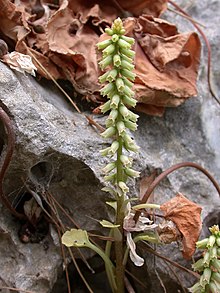Venus navel
| Venus navel | ||||||||||||
|---|---|---|---|---|---|---|---|---|---|---|---|---|

Real Venus navel ( Umbilicus rupestris ) |
||||||||||||
| Systematics | ||||||||||||
|
||||||||||||
| Scientific name | ||||||||||||
| Umbilicus | ||||||||||||
| DC. |
Venus navel ( Umbilicus ), also known as umbilical herb, is a genus of plants within the family of thick-leaf plants (Crassulaceae).
description



Vegetative characteristics
The species of the genus Umbilicus are relatively small, bare, persistent , more or less deciduous, succulent herbaceous plants . Except for Umbilicus oppositifolius , they almost always have a bulbous or rhizome-like "rhizome". The soft, fleshy leaves are stalked, almost circular, usually (except for Umbilicus oppositifolius ) more or less shield-shaped and have a depression in the middle. The leaf margin is crenate or toothed . The leaves on the shoots are usually smaller and smaller towards the top and are linear-lanceolate in shape.
Generative characteristics
The mostly relatively long and sometimes branched, terminal, racemose or panicle inflorescences usually contain many sometimes upright, but mostly horizontal or hanging flowers. The hermaphrodite flowers are five-fold and obdiplostemon with a double flower envelope . The five petals are tubular or bell-shaped fused. The five corolla lobes are erect or spread out at the top. The petals are white, green or yellow in color and sometimes tinged with purple.
The fruit is a slim follicle fruit .
Systematics and distribution
The genus Umbilicus was founded in 1801 by Augustin-Pyrame de Candolle in Bull. Sci. Soc. Philom. Paris , 3, page 1 drawn up. The botanical genus name Umbilicus is derived from the Latin word for "navel" and refers to the navel-like deepening of the shield leaves.
The genus Umbilicus is distributed in Western and Central Europe , Macaronesia , the Mediterranean region , the Middle East , from Western Asia to the western Caucasus , on the Arabian Peninsula and in North, Central and East Africa.
According to Colin Charles Walker (* 1952) the genus Umbilicus is divided into two sections in 2003 and contains the species:
- Umbilicus section
- Umbilicus albido-opacus Carlström : It occurs on islands in the eastern Aegean.
- Umbilicus botryoides Hochst. ex A.Rich.
- Umbilicus chloranthus Heldr. & Sart. ex Boiss. : It occurs only in Apulia , on the Balkan Peninsula, in the Aegean Sea and in Asia Minor.
- Umbilicus citrinus Wolley-Dod
- Upright Venus navel ( Umbilicus erectus DC. , Syn .: Umbilicus luteus (Hudson) Webb & Berthel. ), Native to: Southern Italy, Balkan Peninsula, Aegean Sea, Turkey, Syria, Lebanon
- Umbilicus heylandianus Webb & Berthel. : It occurs only in Spain, Portugal and Morocco.
- Horizontal Venus navel ( Umbilicus horizontalis (Guss.) DC. ),
- Umbilicus horizontalis var. Horizontalis
- Umbilicus horizontalis var. Intermedius (Boiss.) Chamberlain (is also regarded as a separate species Umbilicus intermedius Boiss. ); Home: Turkey, Syria, Palestine, Iran, Egypt
- Umbilicus paniculiformis Wickens , home: Sudan
- Umbilicus parviflorus (Desf.) DC. : It occurs on the Greek islands (Crete, Aegean) and in Asia Minor .
- Umbilicus patens Pomel , native to North Africa
- True Venus navel or rock umbilical herb ( Umbilicus rupestris (Salisb.) Dandy ); Home: Southern and Western Europe, Turkey, Cyprus, Syria, Madeira, Libya, Northwest Africa
- Umbilicus schmidtii Bolle , home: Canary Islands
- Umbilicus tropaeolifolius Boiss. , Home: Middle East.
- Section Chiastophyllum Ledeb. (Is also regarded as a separate genus Chiastophyllum (Ledeb.) A.Berger ). The species of the Chiastophyllum section differ from those of the Umbilicus section by their fibrous roots and the opposite, non-shield-shaped leaves.
- Forest thick sheet ( Umbilicus oppositifolius .. (Ledeb ex Nordm) Ledeb. , Syn .: Chiastophyllum oppositifolium (Ledeb ex Nordm) Stapf.. Ex A. Berger ); Homeland: Georgia (West Caucasus).
proof
literature
- Urs Eggli (ed.): Succulent lexicon. Crassulaceae (thick leaf family) . Eugen Ulmer, Stuttgart 2003, ISBN 3-8001-3998-7 , pp. 381-382 .
- Jaakko Jalas, Juha Suominen, Raino Lampinen, Arto Kurtto: Atlas florae europaeae. Volume 12: Resedaceae to Platanaceae. Helsinki 1999, ISBN 951-9108-12-2 , pp. 47-51.
Individual evidence
- ↑ a b K. Marhold, 2011: Crassulaceae. : Datasheet Umbilicus. In: Euro + Med Plantbase - the information resource for Euro-Mediterranean plant diversity .
- ^ A b Colin Charles Walker: Umbilicus. In: Urs Eggli: Succulents Lexicon , Volume 4: Crassulaceae (thick-leaf plants). 2003, pp. 381-382.
- ↑ a b c Walter Erhardt et al .: The great zander. Encyclopedia of Plant Names. Volume 2. Verlag Eugen Ulmer, Stuttgart 2008, ISBN 978-3-8001-5406-7 .
- ^ Umbilicus in the Germplasm Resources Information Network (GRIN), USDA , ARS , National Genetic Resources Program. National Germplasm Resources Laboratory, Beltsville, Maryland. Retrieved August 19, 2020.